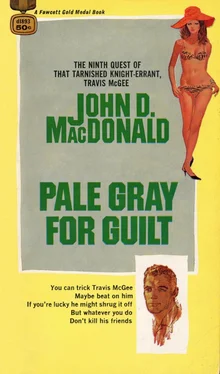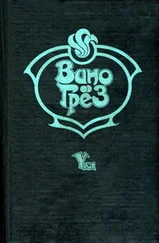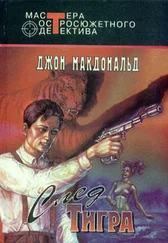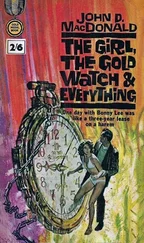John D. MacDonald
Pale Gray for Guilt
“Perhaps no one can be really a good appreciating pagan who has not once been a bad puritan.”
— BOURNE
The next to the last time I saw Tush Bannon alive was the very same day I had that new little boat running the way I wanted it to run, after about six weeks of futzing around with it.
So on the test run I demonstrated one of our contemporary maladies: You can’t just go out and ride around in car, boat, or airplane — you have to have a destination.
Then you feel purposeful.
So in the early morn on a flat, calm, overcast day I stocked the ice chest on the little Muñequita from my ship’s stores on The Busted Flush , locked up the Flush , dropped down into my new playtoy, and, as what faint breeze there was seemed to be coming out of the southwest, I stuck my nose out of the pass to see if I could run north outside. The long, slow gray-green lift and fall of the ground swell was all of a towering five inches high, so I took it a mile off the beaches and fooled with the rpm and the fuel flowmeter, until she was riding right and sounded right and just a hair under 3,000 on each of the OMC 120-horse stern-drive units. I then turned the steering over to the little Calmec autopilot, took a bearing on the Lauderdale Municipal Casino and noted the time.
That, of course, is one of the fussy little enchantments of a new boat — new being either brand-new or second-hand new. What you are hunting for is the optimum relationship between fuel consumption and distance. You tell yourself that maybe someday you are going to get caught very short, and you are going to have to squeak back into port with no more than half a cup of fuel left, with luck, and it would be very nice to know what rpm leaves you the least chance of running dry.
But like the exercise of caution in almost every human activity, the fusspots who make it their business to know are the ones least likely to ever have that ticklish problem. It’s the ones who never check it out who keep the Coast Guard choppers busy.
The little boat was aimed back up the Florida east coast toward Broward Beach, where I had picked her up on an estate sale from a law firm. She’d belonged to a Texan named Kayd whose luck had run out somewhere in the Bahamas.
It’s a funny thing about boat names. She had that Muñequita across the stern in four-inch white letters against that nice shade of Gulf Stream blue when I brought her on back to Bahia Mar. Spanish for “little doll.” One night Meyer and Irv Deibert and Johnny Dow and I sat around trying to dream up a name that would match The Busted Flush . Little Flush? Inside Straight? Hole Card? The Ante? And I forget which one we decided was best because when I got around to changing it, I looked at the name it had and I decided that trying to match it to the name on the mother ship was a case of the quaints and the cutes, and I liked the name just fine. It was a little doll and had begun to acquire in my mind a personality that could very well resent being called anything else, and would sulk and wallow.
I switched the FM-UHF marine radio to the commercial frequencies and tried to find something that didn’t sound like somebody trying to break up a dogfight in a sorority house by banging drums and cymbals. Not that I want to say it isn’t music. Of course it is music, styled to accompany teenage fertility rites, and thus is as far out of my range as “Rockabye Baby.” FM radio was a great product when it was servicing a fringe area of the great American market. But it has turned into a commercial success, so they have denigrated the sound, and they have mickey-moused the stereo, and you have to really search that dial to find something that isn’t either folk hoke, rickyticky rock, or the saccharine they pump into elevators, bus stations and Howard Johnsons.
As I was about to give up I found some pleasant eccentric, or somebody who’d grabbed the wrong record, playing Brubeck doing Cole Porter, and I caught it just as he opened up “Love for Sale” in a fine and gentle manner, and then handed it delicately over to Desmond, who set up a witty dialogue with Joe Morello.
After telling myself that ten of eight in the morning is beer time only for the lowest types, I cracked a bottle of Carta Blanca and stood in the forward well, leaning through the center opening where I’d laid the hinged windshield over to port, out of the way, forearms on the smoke-blue foredeck shell.
Well, I was on my way to see old Tush after too long, and I had wind in my face like a happy dog leaning out a car window. The wake was straight. The engines ran sweetly in sync. I could feel the slow rise and fall in the imperceptible ground swell. The overcast was starting to burn off, the sea starting to glint. I could see pigmy figures over on the beach by Sea Ranch. Even with the investment in the playtoy, I still had a comforting wad of currency back in the cache aboard The Busted Flush at Slip F-18, Bahia Mar.
It had been a fine long hot lazy summer, a drifting time of good fish, old friends, new girls, of talk and laughter.
Cold beer, good music and a place to go.
That’s the way They do you. That’s the way They set you up for it. There ought to be a warning bell on the happy-meter, so that every time it creeps high enough, you get that dang-dang alert. Duck, boy. That glow makes you too visible. One of Them is out there in the boonies, adjusting the windage, getting you lined up in the cross hairs of the scope. When it happens so often, wouldn’t you think I’d be more ready for it?
I took my right-angle sight on a water tower just beyond Ocean Ridge, one that measures almost exactly thirty miles north of the Municipal Casino, and my elapsed time was sixty-two minutes. I wrote that down, along with fuel consumption, so I could do the math later, breaking it down in the way that to me is easiest to remember, statute miles per gallon at x rpm.
The wind was freshening and quartering into the south, and though I was still comfortable, I decided it wasn’t going to last very long, so I went through Boynton Inlet into Lake Worth. The OMC’s were still green enough so that too much constant speed wasn’t the best thing in the world, so as soon as I had a nice open straightaway up the Waterway without traffic, I pushed it up to 4,200 rpm, estimating it at about 45 miles an hour. I estimated I had fifty if I ever needed it, and hoped I’d never get in a bind where I needed it. I held her there for five or six minutes, then dropped it way back, getting it to that minimum rpm that, depending on gross weight at the time, would just hold it on the plane. It wasn’t a rig I was about to take out and see if I could get to Nassau ahead of Wynne and Bertram and those people, taking those thirty-foot leaps and turning your spine into a concertina every time you smash back into the sea, pulping your kidneys and chomping your jaw into the foam rubber tooth guard. The little Muñequita would have had to be turned into a racing machine, with a hundred more horses in each mill, special wheels, a lot more bracing and reinforcement to keep the engines in her, and then she would not be much good for anything else.
Besides, I had been talked into trying it once. I think you could maybe argue the point that it is a little more fun than a hungover, carbuncled cowboy might have while trying to stay aboard a longhorn in a dusty rodeo, but it would be a close decision.
When I reached the bay north of Broward Beach, I had to look at the chart to see at which marker I should leave the Waterway to hit the mouth of the Shawana River. So it was ten thirty of that Tuesday morning, or a little later, when I eased up to one of the finger piers at Bannon’s Boatel, put a line on a piling and cut the engines off.
Читать дальше










![Джон Макдональд - Wine of the Dreamers [= Planet of the Dreamers]](/books/430039/dzhon-makdonald-wine-of-the-dreamers-planet-of-thumb.webp)

